Litóhoro, Pieria, Greece, Wednesday, 21 March 2001
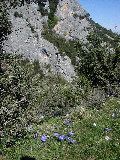
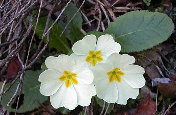
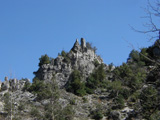 Last Thursday Paul and Joann returned here, bringing Stas's sister Elizabeth and her little boy Brendan (who will be nine in June), both now in Greece for the first time ever. Friday we all nine went for a hike in the gorge, where the wildflowers have been coming along very nicely as you can see at right, and also for a bit of a walk at the beach. These vistas were entirely new even to Paul and Joann, and all were suitably enthralled, including us to whom they are not so new.
Last Thursday Paul and Joann returned here, bringing Stas's sister Elizabeth and her little boy Brendan (who will be nine in June), both now in Greece for the first time ever. Friday we all nine went for a hike in the gorge, where the wildflowers have been coming along very nicely as you can see at right, and also for a bit of a walk at the beach. These vistas were entirely new even to Paul and Joann, and all were suitably enthralled, including us to whom they are not so new.
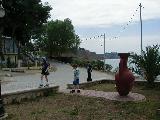
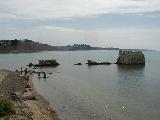
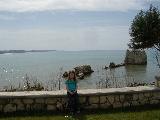 On Sunday we set out in Paul's rented nine-passenger van for a three-day trip to northeastern portions of the country. We started with a tour of Chalcidice (Halkidikí); our first stop was at the isthmus of the first of its three peninsulas. It was somewhere right about here that Socrates did his bit for Athens in the Peloponnesian War, at the siege of Potidaea. I commented that his saving Alcibiades' life on that campaign may well have been the worst mistake of the great philosopher's life, as Alcibiades later did more than probably anyone else to lose the war for Athens, with disastrous consequences for Athens and fatal consequences for Socrates himself.
On Sunday we set out in Paul's rented nine-passenger van for a three-day trip to northeastern portions of the country. We started with a tour of Chalcidice (Halkidikí); our first stop was at the isthmus of the first of its three peninsulas. It was somewhere right about here that Socrates did his bit for Athens in the Peloponnesian War, at the siege of Potidaea. I commented that his saving Alcibiades' life on that campaign may well have been the worst mistake of the great philosopher's life, as Alcibiades later did more than probably anyone else to lose the war for Athens, with disastrous consequences for Athens and fatal consequences for Socrates himself.
We then toured the circumference of the middle peninsula. We stopped halfway down the west side for lunch at a beautiful beach-front "Psarotaverna" (fish restaurant), where the children waded into the sea and went a little too far, so that changes of clothing became necessary. When we got around to the east side we could see the "holy mountain," Athos, on the third peninsula, across the water, where monastic orders have a kind of autonomous republic. There females even of sheep and other cattle are strictly excluded, in order to shield the brothers from temptations that their predecessors reportedly found all too irresistible. It was a very scenic drive (though none of my few photos turned out worth posting), but much longer and slower than we were counting on, so that a considerable chunk of night-time driving was necessary before we caught the very last ferry of the day from Keramotí to the island (and town) of Thasus (Thásos).
We landed at half past nine, and promptly got lost, what with having both the name and directions to our hotel wrong; but finally the young woman in charge of the hotel came on foot to meet us back at the port, got in the van, and steered us right. (She sported one of the most unusual coiffures any of us had ever seen, long and black in front but very short and blonde behind.) We settled in for two nights in a rather splendid old house crammed with very ethnic antiques, and with wonderful slate-flagged floors. Stas went straight to bed, and the young woman steered the rest of us (now on foot) to a humble souvláki joint for a very late dinner even by Hellenic standards, it seemed. It was just about the only place still open, and they were down to just two items for the grill: I tried a spicy regional sausage while everyone else got hot dogs. Our weary party also depleted their entire remaining stock of ouzo in 200ml bottles.
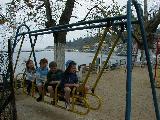 The next morning we went to the old port for breakfast (the less said the better) and to let the children disport themselves at a nice playground by the wharf, lined by plane trees with whitewashed trunks. While ducking back to the hotel Paul and Joann and I lucked out and got a special private showing of some of the pieces in the archaeological museum, which has been closed for the past six years for improvements that seem not to be in any advanced state of progress even now. Joann particularly wanted to revisit two old "friends" from their first trip to Greece in 1984: a small statuary group of Aphrodite and Eros riding a dolphin, and a large archaic koúros (naked young man) holding a ram.
The next morning we went to the old port for breakfast (the less said the better) and to let the children disport themselves at a nice playground by the wharf, lined by plane trees with whitewashed trunks. While ducking back to the hotel Paul and Joann and I lucked out and got a special private showing of some of the pieces in the archaeological museum, which has been closed for the past six years for improvements that seem not to be in any advanced state of progress even now. Joann particularly wanted to revisit two old "friends" from their first trip to Greece in 1984: a small statuary group of Aphrodite and Eros riding a dolphin, and a large archaic koúros (naked young man) holding a ram.
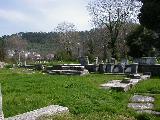 Next we visited the ancient agora (the central public space for commerce, politics, and religion), excavated by the French school throughout the twentieth century. As at most ancient Greek archaeological sites, most of what you see are foundations of buildings (many of them post-classical, Hellenistic or Roman) and assorted architectural scraps; but this is one of the more interesting and impressive sites of this type. My waterproof boots came in handy on the marshy ground; others were less well served by sandals or sneakers.
Next we visited the ancient agora (the central public space for commerce, politics, and religion), excavated by the French school throughout the twentieth century. As at most ancient Greek archaeological sites, most of what you see are foundations of buildings (many of them post-classical, Hellenistic or Roman) and assorted architectural scraps; but this is one of the more interesting and impressive sites of this type. My waterproof boots came in handy on the marshy ground; others were less well served by sandals or sneakers.


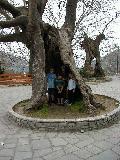 Next we all drove to the mountain village of Megálo Prínos in the island's interior. Along the way we noticed that the road cuttings consistently revealed the island's famous marble. The village was very quaint and scenic (with a great hollow plane tree in the square) but offered no lunch or even coffee for travelers before the regular tourist season, so we returned to Thasus town for lunch and then split up. Paul and Joann drove to the far side of the island, I went on a walking tour of the town's ancient sanctuaries and defenses, and the rest went to a beach. Mine seems to have proven the most worthwhile option, the weather being less than fine.
Next we all drove to the mountain village of Megálo Prínos in the island's interior. Along the way we noticed that the road cuttings consistently revealed the island's famous marble. The village was very quaint and scenic (with a great hollow plane tree in the square) but offered no lunch or even coffee for travelers before the regular tourist season, so we returned to Thasus town for lunch and then split up. Paul and Joann drove to the far side of the island, I went on a walking tour of the town's ancient sanctuaries and defenses, and the rest went to a beach. Mine seems to have proven the most worthwhile option, the weather being less than fine.

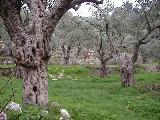
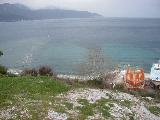 The way took me past the "Dimitriádis Quarter," classical and earlier ruins of a residential area, and past gnarled old olive trees set in stone-fenced terraces on the hillside It also offered views down to the shore and the sea, where old-fashioned caïques were still being built for the fishing fleet.
The way took me past the "Dimitriádis Quarter," classical and earlier ruins of a residential area, and past gnarled old olive trees set in stone-fenced terraces on the hillside It also offered views down to the shore and the sea, where old-fashioned caïques were still being built for the fishing fleet.
 The walls themselves were in a surprisingly good state of preservation in many places, considering that the youngest portions of these fortifications date from the Peloponnesian War (431-404 B.C.).
The walls themselves were in a surprisingly good state of preservation in many places, considering that the youngest portions of these fortifications date from the Peloponnesian War (431-404 B.C.).
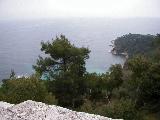
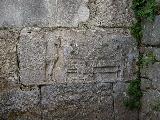
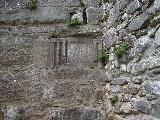 The circuit of the walls and accordingly the walking route go up to the three-peaked hill of the acropolis. The first and lowest of these hilltops once held a sanctuary of Pythian Apollo, according to the inscriptions found on the site. The aforementioned koúros was found here, according to a placard, having been intended for dedication to the god but disqualified by a mishap in the carving, and so used merely as masonry fill. But what occupies the spot now is a medieval fort built by the Italians, using some materials clearly cannibalized from the classical site, including a fine fifth-century-B.C. relief of a funeral scene, and a triglyph from a Doric temple (both shown at right).
The circuit of the walls and accordingly the walking route go up to the three-peaked hill of the acropolis. The first and lowest of these hilltops once held a sanctuary of Pythian Apollo, according to the inscriptions found on the site. The aforementioned koúros was found here, according to a placard, having been intended for dedication to the god but disqualified by a mishap in the carving, and so used merely as masonry fill. But what occupies the spot now is a medieval fort built by the Italians, using some materials clearly cannibalized from the classical site, including a fine fifth-century-B.C. relief of a funeral scene, and a triglyph from a Doric temple (both shown at right).
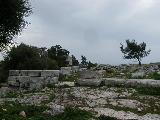
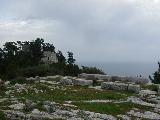 The next hilltop held a sanctuary and temple of Athena Poliouchos, of which the foundations remain. The nearer photo left looks back from this hilltop to the previous one with its medieval fort. Photos just below show prospects from this eminence, including one of the whole town and a more particular bird's-eye view of the agora site.
The next hilltop held a sanctuary and temple of Athena Poliouchos, of which the foundations remain. The nearer photo left looks back from this hilltop to the previous one with its medieval fort. Photos just below show prospects from this eminence, including one of the whole town and a more particular bird's-eye view of the agora site.
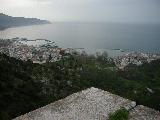
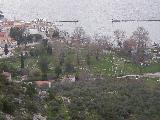
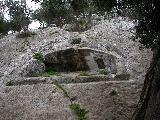 The third and highest hilltop is also the rockiest. This little shrine of Pan was carved right into the living rock.
The third and highest hilltop is also the rockiest. This little shrine of Pan was carved right into the living rock.
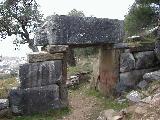 There is even one gate on the tour that still retains its lintel from the dangerous times of the Peloponnesian War. The peerless historian of that war, Thucydides, had the running of the gold mines on this island, and from here launched his unsuccessful attempt to lift the siege of Amphipolis. This is called the gate of Parmenon, because a few dozen paces away one of the wall blocks is inscribed "Parmenon made me."
There is even one gate on the tour that still retains its lintel from the dangerous times of the Peloponnesian War. The peerless historian of that war, Thucydides, had the running of the gold mines on this island, and from here launched his unsuccessful attempt to lift the siege of Amphipolis. This is called the gate of Parmenon, because a few dozen paces away one of the wall blocks is inscribed "Parmenon made me."
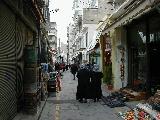 The next morning we took the ferry back to the mainland (much newer and nicer than the one we took out). We then went further east, into Thrace, and the town of Xánthi, for some souvenir shopping: some of our party hoped to find embroideries here, but were disappointed. The increasing admixture of Turkish and Bulgarian cultures in this far northeast region was apparent in the little fleamarket streets.
The next morning we took the ferry back to the mainland (much newer and nicer than the one we took out). We then went further east, into Thrace, and the town of Xánthi, for some souvenir shopping: some of our party hoped to find embroideries here, but were disappointed. The increasing admixture of Turkish and Bulgarian cultures in this far northeast region was apparent in the little fleamarket streets.
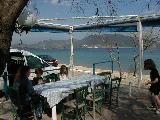
 After turning back west again we stopped at Néos Péramos for another beachfront psarotaverna lunch. This time we were able to get by without changes of clothes, which was a very good thing on the last of our planned three days.
After turning back west again we stopped at Néos Péramos for another beachfront psarotaverna lunch. This time we were able to get by without changes of clothes, which was a very good thing on the last of our planned three days.
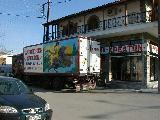 Our last stop was at Néa (i.e. "New") Máditos, one of many towns and villages in this region built by and for refugees from the 1922 "Asia Minor Catastrophe." The original Máditos, near the Hellespont, had just become part of Ataturk's new Turkish state, and its Greek population was forced to migrate westward. Paul's parents were among them; though they never came here themselves (emigrating instead to America), many of their acquaintance lived here and were the parents and grandparents and great-grandparents of today's townsfolk. While we were waiting for Paul to make his connections I spied and photographed this meat truck delivering to a butcher, with a fair representation painted on the side of Zeus in the form of a bull abducting Europa.
Our last stop was at Néa (i.e. "New") Máditos, one of many towns and villages in this region built by and for refugees from the 1922 "Asia Minor Catastrophe." The original Máditos, near the Hellespont, had just become part of Ataturk's new Turkish state, and its Greek population was forced to migrate westward. Paul's parents were among them; though they never came here themselves (emigrating instead to America), many of their acquaintance lived here and were the parents and grandparents and great-grandparents of today's townsfolk. While we were waiting for Paul to make his connections I spied and photographed this meat truck delivering to a butcher, with a fair representation painted on the side of Zeus in the form of a bull abducting Europa.
previous entry
next entry
main/ToC page


 On Sunday we set out in Paul's rented nine-passenger van for a three-day trip to northeastern portions of the country. We started with a tour of Chalcidice (Halkidikí); our first stop was at the isthmus of the first of its three peninsulas. It was somewhere right about here that Socrates did his bit for Athens in the Peloponnesian War, at the siege of Potidaea. I commented that his saving Alcibiades' life on that campaign may well have been the worst mistake of the great philosopher's life, as Alcibiades later did more than probably anyone else to lose the war for Athens, with disastrous consequences for Athens and fatal consequences for Socrates himself.
On Sunday we set out in Paul's rented nine-passenger van for a three-day trip to northeastern portions of the country. We started with a tour of Chalcidice (Halkidikí); our first stop was at the isthmus of the first of its three peninsulas. It was somewhere right about here that Socrates did his bit for Athens in the Peloponnesian War, at the siege of Potidaea. I commented that his saving Alcibiades' life on that campaign may well have been the worst mistake of the great philosopher's life, as Alcibiades later did more than probably anyone else to lose the war for Athens, with disastrous consequences for Athens and fatal consequences for Socrates himself.


 Last Thursday Paul and Joann returned here, bringing Stas's sister Elizabeth and her little boy Brendan (who will be nine in June), both now in Greece for the first time ever. Friday we all nine went for a hike in the gorge, where the wildflowers have been coming along very nicely as you can see at right, and also for a bit of a walk at the beach. These vistas were entirely new even to Paul and Joann, and all were suitably enthralled, including us to whom they are not so new.
Last Thursday Paul and Joann returned here, bringing Stas's sister Elizabeth and her little boy Brendan (who will be nine in June), both now in Greece for the first time ever. Friday we all nine went for a hike in the gorge, where the wildflowers have been coming along very nicely as you can see at right, and also for a bit of a walk at the beach. These vistas were entirely new even to Paul and Joann, and all were suitably enthralled, including us to whom they are not so new.





















